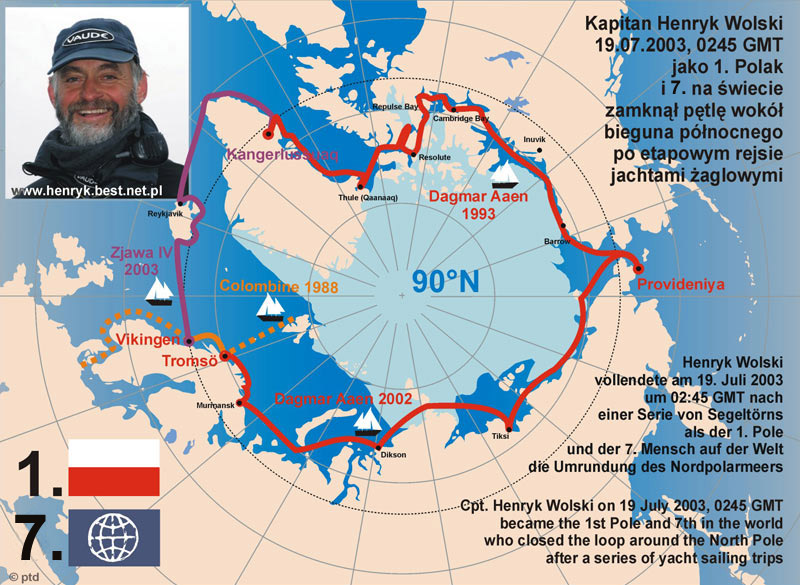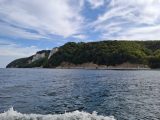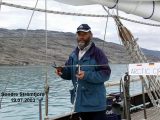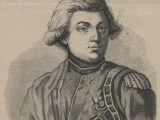People were forced to sail in the so-called high northern latitudes by necessity. When in 1493 and 1994 Pope Alexander VI divided the world between Portugal and Spain with the Treaty of Tordesillas, the path to the riches of the Far East became closed to other nations. The Portuguese guarded the route around the Cape of Good Hope, and the Spanish guarded the Strait of Magellan. So they began to look for alternative waterways. This is how the search for the so-called Northeast and Northwest Passage began. Initially, it was thought that there was another possibility, a route through the North Pole. Scientific authorities such as Petrus Plancius, and later August Petermann, were convinced that when sailing towards the North Pole, one would come across a narrow strip of ice, through which one had to break through, and then “up” to the pole and then “down” one would sail on clear water. Then one had to break through the strip of ice again and the path to the Pacific was open. Time passed. The Spanish and Portuguese ceased to rule the waters of the world and there was no longer any need to search for alternative waterways. However, the desire to discover these Passages and also to reach the North Pole remained, even though it was already known that one could not sail there by ship. The desire to discover the undiscovered, and even to rediscover the already discovered, remained. Captain Dariusz Bogucki once put it aptly in one of his books. The wake of a ship after it has passed leaves a short trace on the water. The next ship must search for its own routes at its own expense. This is of course a truism; there are maps, and now it is even possible to take over an electronically recorded trace. Nevertheless, it is not a land route, and the trace on the water remains invisible, so Captain Bogucki’s statement has its deep meaning.

On July 19, 2003, 20 years ago, I completed a loop around the North Pole, becoming the first Pole and the seventh person in the world (the first was Amundsen) to do so on sailing ships. The circumnavigation of the pole consisted of a series of voyages. In 1991–94, I took part in the ICESAIL expedition organized by Arved Fuchs.

The expedition’s goal was to circle the North Pole

on the yacht “Dagmar Aaen”.

In 1991, the yacht began to push through the Northeast Passage, or the so-called Great Northern Route – as the Russians call it, the route leading from Scandinavia north of Siberia to the Bering Strait. In September 1991, the political system in Russia changed. Yeltsin replaced Gorbachev. The political situation was unstable. The yacht wintered inland in Igarka, on the Yenisei River. The following year, 1992, we made another attempt to push through the Northeast Passage. We reached the port of Dikson, located at the mouth of the Yenisei. Here we began waiting for the ice conditions to improve, which would allow us to continue sailing east. There was no significant improvement. We had indeed sailed a little farther east and reached longitude 094°40.9’E at latitude 76°16.3’N, but we had not even reached Cape Chelyuskin, the northernmost point of Eurasia.

It was already September and there was no hope for the ice conditions to improve. The so-called young ice had already started to form.

After two unsuccessful attempts to sail through this waterway, we withdrew to Norway. The yacht spent the winter in Tromsø. The expedition was generously planned for 4 years. One year of the Northeast Passage, one year of pure exploration of the Aleutian Islands, the Northwest Passage (the route between Alaska, the Canadian archipelago and Greenland) and one year in reserve. 2 years had already passed, two sailing seasons, and we had not achieved anything, apart from gaining experience. We decided to change the direction of travel.

The following year, 1993, the yacht sailed from Tromsø to Greenland. I did not participate in this part. In July of that year, I joined the crew in Greenland in the town of Kangerlussuaq.
First, we sailed to the north of Greenland to the town of Thule, and then along the almost classic route, one could say in the footsteps of Amundsen from 1903-06. It was not without adventures. In Thule, we were offered to take part in the fight against the so-called inbreeding, but Arved, like the dog in the manger, rejected the offer. Before entering the “Bellot Strait”, we were squeezed in the ice. The yacht tilted so much to the side that we feared it would sink. We evacuated to the ice and passively watched the events unfold. The yacht did not sink, and we carefully returned to it. After less than a week, the ice freed us from its shackles. Finally, in October, we reached Dutch Harbor in the Aleutians. We sailed the entire Northwest Passage, including the Beaufort Sea and the Bering Strait.

Dutch Harbor, a non-freezing port, was the wintering place of the “Dagmar Aaen”. We returned to our homes, only to return here again the following year to make another attempt to force the Northeast Passage westward. In 1994, we first sailed from Dutch Harbor to the Russian Provideniya. And again the wait for favorable ice conditions began. At this point it is worth adding that they are not the only ones that affect navigation in this water. The consent of local officials is also necessary, and they are not always positively disposed to cooperation and sometimes special measures have to be used to convince them. We passed Cape Dezhnev (the easternmost tip of Asia) on the port side on August 16, 1994.


Initially, we sailed almost unhindered, but it soon started to get tighter and tighter. On 24 August we were surrounded by ice from all sides.
Chris – an Australian crew member – flew our flying vehicle, built on a dinghy base, for aerial reconnaissance. He returned an hour later with the information that there was no passage through the ice.


The barometer was falling and a powerful storm had broken out during the night. We had a tactic prepared for such an eventuality, tested earlier. First, we meticulously searched for a suitable large and stable ice floe, which additionally had the right shape. The condition was that it had to have something like a bay. We sailed into this bay, moored to its shores. Now, all the knocking against other floes was taken on by our floe, and we remained in its depression, the so-called ice port, almost untouched.

Ice harbour.

Everything was going according to plan until our floe broke. From then on, the floes started to come at us from everywhere. The situation was getting worse and worse. The ship was being squeezed and was tilting. We couldn’t even dream of getting out on the ice, just like last year. Everything was in constant motion and there was not a single orifice around us that was suitable for evacuation. It seemed to be the end. The ice pilot Anatoly, who spoke little English, looked around and said “five minutes”. That was as much as we still had left in his estimation.
With complicated sailing manoeuvres we managed to pull the ship off the ice floe and pull the whole thing out of the galley. In the morning we moored to the edge of the ice in completely calm waters. However, the ship took quite a beating; we had a damaged rudder and battered planes. On 30 August 1994 we started our retreat. The fourth season was coming to an end. On the plus side, we were able to record the Northwest Passage done last year in one season. This was the end of the 4-year ICESAIL Expedition to circumnavigate the North Pole. We had had enough of ice and russian officials.
In 2000, I took part in the Antarctic expedition organized by Arved, “In Shackleton’s Footsteps”, on the lifeboat “James Caird II”. After its successful completion and after gaining distance from our negative experiences from the ICESAIL expedition, Arved’s mind had – one might say – free capacity. He agreed to organize another expedition, the goal of which was the Northeast Passage.


In 2002, ‘Dagmar Aaen’ left German waters. We found ourselves in Tromsø again and sailed east. In Dikson we met the French yacht ‘Vagabond’ on which Wojtek Jacobson and Ludek Mączka had passed the Northwest Passage in 1982. Now, the new owner, Eric Brossier, was in the process (like us) of forcing the North-East Passage.

We reached Cape Čeluskin 77°43.3’N 104°15.9’E on 12 August almost without problems.

It has been 10 years since we were last here (1992). Conditions have improved dramatically. The climate change was clearly perceptible. There was considerably less ice. In addition, we were able to download ice and weather maps ourselves. These are the results of technical progress. Before, information on the state of the ice was compiled on the basis of aerial observations, from planes specially sent out by the relevant authorities for this purpose. Such reconnaissance flights were organised when a convoy was expected to pass. Everything became easier. After passing Cape Chelyuskina, we visited the Yakutian port of Tiksi, located in the mouth of the Lena River in the Laptev Sea, and then Vrangla Island, located between the East Siberian Sea and the Chukotka Sea.
On 2 September 2002, we anchored at a place called ‘The Scythe of Two Pilots’, a place that was our westernmost point reached in 1994. It was then 25 August. “Dagmar Aaen” had circumnavigated the North Pole. Along with her were Arved Fuchs and Slava Melin. I hadn’t yet, because I hadn’t participated in the stage from Tromsø to Kangerlussuaq. The decision was made. Next year I will want to fill the gap and organise a cruise from Norway to Greenland.

I flew from Provideniya (Providence) via Anadyr to Moscow with Slava, and from Moscow to Warsaw. My first steps were directed to Wojtek Skórski. The yacht being built for me was not ready and there was no indication that it would be ready next year. However, Wojtek, who works at MEL at the Warsaw University of Technology, said that he knew students who would be willing to organise a cruise. What was needed, of course, was a yacht.
The choice fell on ‘Zjawa IV’ belonging to CWMiW – ZHP.

It was a yacht, perhaps not in perfect condition, but perfectly suited for the purpose. A strongly built ship according to designs once developed by the famous Norwegian designer Colin Archer.

“Zjawa IV”, before it was adopted as a yacht, served as a rescue sailing vessel. It was similar in size to “Dagmar Aaen”. Moreover, its name had a symbolic meaning for me. Władysław Wagner was the first Polish sailor to sail around the world on three consecutive “Zjawas”. For me, it was also a sail around the world on three yachts in four sections. The first was the yacht “Colombine” – Swan 38, on which I sailed from Germany along Norway to Spitsbergen and back in 1988.
After that, the idea of sailing through the Northeast Passage was born. I started looking for a suitable yacht. I chose “Gedania”, which was undergoing a major renovation, and the deadline for its completion was extended. In the meantime, I learned that Arved Fuchs was preparing an ICESAIL expedition, the aim of which was to sail around the North Pole. I managed to join her almost at the last minute. Fortunately, because the renovation of Gedania was not finished yet.
So first “Colombine” then two Passages to “Dagmar Aaen” and now the symbolic ending on Zjawa IV.


I stayed in Warsaw with Wojtek for a short time. I was in a hurry to get to the annual archaeological festival in Biskupin, where my “Welet” – a Slavic boat – had traditionally participated for several years.
In the meantime, things started to gain momentum. Wojtek’s students Tomek Zielinski-Zielony and Ola Połcik founded the company “Navigare” and efficiently took care of the organisation of the voyage, which started to grow into a big, multi-stage expedition. First, ‘Zjawa’ was to sail from Norway to Greenland. Iceland, with its northernmost Cape Horn, was to be circumnavigated from the north (leave on the port side), and then in stages go south to Ushuaia and from there make several voyages around the Horn (the famous one) and to Antarctica. Thus, the name of the whole expedition ‘From Horn to Horn’ was born.

As part of my two Norway – Iceland – Greenland legs (with a crew change in Reykjavik), the aim of which was to close the loop around the North Pole, another aspect of the expedition emerged; a cruise in the ‘Footsteps of Eric the Red’.
“I took over the ‘Zjawa IV’ in Norway, in Nansos on 4 June 2003. From there we sailed further north. We passed the island of Vikingen, on which stands a globe-shaped metal monument, a significant place where the Arctic Circle passes through, on 7 June. The monument stands at latitude 66°32′ N.
This place should be taken symbolically, as the Arctic Circle is currently at 66° 33`48`N and continues to move northwards at a speed of about 14.5 m per year. This is due to the change in the account of the inclination of the Earth’s axis to the plane of the ecliptic.
We passed the Vikingen islet on 6 June 2003. Previously, on the yacht ‘Colombine’, I passed it on my way from Spitsbergen on 7 July 1988.


After passing it, we turned west. After a few days, we reached the port of Seydisfjoerdur. Here, the previous boatswain Zenek disembarked. It was difficult to sail on the “Zjawa” without a boatswain. The technology gathered there required special care. The power generator was constantly malfunctioning. In Seydisfjoerdur, Providence sent Graham, an Australian who had travelled around the world, but – as he pointed out – on the surface, so an airplane was out of the question. Graham had been on the road for several years. Now he wanted to get to Greenland. After a short conversation, I decided to accept him into the crew as a boatswain. In the next port, Akureyri, Marek Łukomski – Engineer – joined the crew. I deliberately write the word engineer with a capital I, because in Marek’s case, this word means not only a profession, but also character. Together with Graham, they took care of the engine room, the electrical system and the water tank system. The completion of the work was celebrated with a party in the engine room, the so-called mazini-party. (Once Graham, poring over the signs on individual parts in the engine room, came to me and asked what mazini meant in Polish. I said there was no such word and that it sounded more like Italian. However, he insisted that he had seen such an inscription. There was no other way, we went down together and Graham showed me the inscription “machine pump”) We passed Horn, the northernmost tip of Iceland on June 20.


After arriving in Reykjavik, we took a trip to Búðardalur located deep in the Breidafjoerdur fjord. There are reconstructions of a Viking hut and a monument to Leif Eriksson, son of Erik the Red. It was from here that, in the year 985, 25 ships under the command of Erik the Red were to set sail with the intention of settling Greenland.


There was a change of crew in Reykjavik.
Greenland can be circumnavigated from the south in two ways; south of Kap Farvel, or via Prins Christian Sund.


We chose the latter option. I can’t help but draw a certain analogy between this place and South America. Like Greenland, it can be circumnavigated from the south around Cape Horn or via the Beagle Channel (or yet another route through the Strait of Magellan).

I sailed around Cape Horn, already with a different crew, on ‘Zjaw IV’ later that year, namely on 2 December 2003.
Being already on the west coast of Greenland, we of course visited Brattahild in Eriksfjord, the places where Erik the Red founded the so-called Eastern Settlement. Here there are also reconstructions of a hut, a chapel and, of course, a monument to Leif Eriksson.



On 19 July, on our way to Kangerlussuaq, we entered the Söndre Strömfjord and again crossed the Arctic Circle, which I had previously crossed at this point on 13 July 1993.


Thus, on 19 July 2003, I closed the loop around the North Pole. In doing so, I became the first Pole and the 7th man in the world to do so on a sailing ship. The first was Roald Amundsen, who on the sailing ship Maud completed “his” circumnavigation of the Pole in 1920. Amundsen did not want to circumnavigate the Pole at all, it was a kind of “by-product” for him, but I really wanted to do it. I succeeded.


I have written a series of articles published in „Żagle” on the whole series of expeditions.
When I was about 20 years old (I was already a so-called “little captain” at the time) – I dreamt, like almost every sailor, of an around-the-world voyage. I remember the booklet “1000 words about the sea and the ship” by Z. Grabowski and J. Wójcicki, with the help of which I studied the names of the seas that make up the North-East Passage and the North-West Passage. My imagination came up with 3 routes by which I would like to circumnavigate the world:
- in the Passat, through the Panama and Suez Canals,
- in the so-called “roaring forties”, i.e. around the 3 famous Cape: Horn, Good Hope and Leeuwin,
- around the North Pole, i.e. the North-East Passage, the North-West Passage and the section between them.
Now, after more than half a century, I can make a summary: Around the North Pole I sailed. Also, I sailed around the 3 Cape Verde Islands, and in the trade winds I crossed the entire Pacific with deviations to Easter Island and Pitcairn. Atlantic in both directions.
My circumnavigation of the world was not breaking any records; I did not participate in any rankings. For me it was the fulfilment of a “boyhood dream” – I would say after the late Ludek Mączka.


